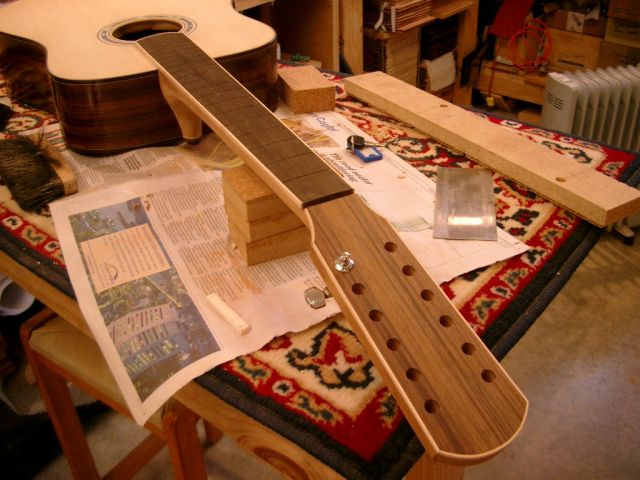Allen wrote:You must be a master of that dovetail joint now Martin. Nice looking package your building there.
I didn't know that there was a preferred way to bind a fret board. I haven't seen the Mayer's DVD's, so can you enlighten those of us that have been stumbling around in the shop trying to get them to look right. The ones I've been doing are heaps of work, and there's gotta be an easier way.
I still havent mastered the dovetail joint. I actually went alot better with the joint on the previous instrument.
Johns method for binding the fretboard. He simply makes the fretboard narrower by an amount to fit width of the binding and then he just glues the binding on.
The sequence of events for binding my fretboard were as follows:
1. level and square up ebony blank.
2. work fretboard to final thickness. I calculate this from neck rake, bridge height etc. On this instrument the fretboard ended up 6.5mm thick.
3. Cut fret slots. I use the Stewmac jig. Depth of slots is checked with a piece of fretwire with tangs filed off.
4. Mark out final shape of fretboard allowing for width of binding on sides of same.
5. Plane fretboard to final shape. Work soundhole end of fretboard into rounded profile on disc sander.
6. Radius fretboard using radius blocks. This fretboard runs from 16 through 12 through 9" radius.
7. Check depth of slots again and deepen if necessary.
8. Bend maple binding on pipe and glue to curved soundhole end of fretboard. Secure with binding tape while glue is setting.
9. Trim ends of binding flush with sides of fretboard. A mitre joint could be done here if you feel so inclined.
10. Glue bindng on sides of fretboard. Again using binding tape to secure. make sure you leave overhang on top and bottom of fretboard to allow for scraping flush.
11. Scrape binding flush with fretboard.

